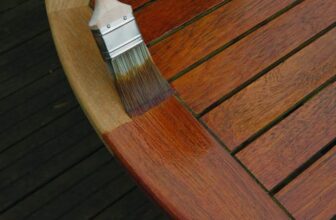Tung oil and linseed oil are two popular wood finishes that have been used for centuries. Both oils can be used to protect, seal, and preserve wooden surfaces from damage caused by water, dirt, and other elements. While both oils offer similar benefits to wood surfaces, there are some key differences between tung oil and linseed oil that should be considered before making a decision about which product is best for your project. In this article, we will explore the characteristics of tung oil vs linseed oil in order to help you make an informed decision when it comes time to choose a wood finish.
Appearance
Tung oil has a strong yellow color, while linseed oil is much lighter in color. Tung oil penetrates deeper into the wood, which gives it a richer and more natural look when applied. Linseed oil sits on top of the wood, providing only surface protection without any additional color or shine.
Durability
Tung oil is more durable than linseed oil, making it ideal for outdoor use or high-traffic areas like floors and furniture. It is also resistant to damage from ultraviolet rays and harsh weather conditions, making it an excellent choice for exterior surfaces. On the other hand, linseed oil does not hold up as well over time and is recommended mainly for indoor applications where there will be less wear and tear on the finish.
Water Resistance
When it comes to water resistance, tung oil is the clear winner. Tung oil forms a protective waterproof barrier on the wood that keeps out moisture and prevents damage from spills and humidity. Linseed oil does not offer much protection against water damage and can be easily wiped away if exposed to large amounts of liquid.
Application Process
The application process for tung oil is slightly more involved than linseed oil as it requires multiple coats to achieve the desired finish. Each coat must be allowed to dry completely before adding additional coats, which can take up to 24 hours for each layer depending on environmental conditions. On the other hand, linseed oil only requires one or two thin coats and can be applied in much less time.

Maintenance
Tung oil requires regular maintenance to keep the finish looking its best. It should be reapplied every 1-2 years in order to maintain the waterproofing benefits and protect against wear and tear. Linseed oil, on the other hand, offers a low-maintenance solution that only needs an occasional touch-up if needed.
Cost
Tung oil is usually more expensive than linseed oil, but the added durability of tung oil makes it a worthwhile investment if you want your wood surface to last longer. On the other hand, linseed oil may be better suited for smaller projects or those on a budget since it provides adequate protection at a lower price point.

Tung Oil vs Linseed Oil – Comparison Table
| Property | Tung Oil | Linseed Oil |
|---|---|---|
| Origin | Derived from the nuts of the Tung tree | Derived from flax seeds |
| Drying time | Relatively fast, usually dries within 24 hours | Slow, can take up to several days to dry |
| Appearance | Provides a more natural, hand-rubbed look | Can yellow over time, especially with exposure to light |
| Durability | Resistant to water and heat, highly durable | Prone to mildew and bacteria, less durable |
| VOCs | Low in volatile organic compounds (VOCs) | Higher in VOCs |
| Penetration | Good penetration saturates the wood well | Limited penetration, may require multiple coats |
| Maintenance | Easy to maintain with occasional reapplication | Regular maintenance and reapplication required |
So Who’s Winner?
There is no clear winner between tung oil and linseed oil. Each has its own unique benefits depending on the application.
Tung oil is a natural, non-toxic product that has been used for centuries to protect and enhance wood surfaces. It is made from the nuts of the Tung tree, which is native to China. Unlike linseed oil, tung oil dries clear and does not yellow over time. It also creates a harder, more durable finish than linseed oil.
Tung oil is also highly water-resistant and can withstand exposure to moisture better than linseed oil. This makes it ideal for outdoor furniture or other items that may be exposed to rain or snow. Additionally, tung oil offers superior protection against pests such as termites or carpenter ants.
Finally, while both oils require regular maintenance and re-coating for peak durability, tung oil requires fewer coats than linseed oil in order to achieve the same level of protection. This makes it a more cost-effective option in the long run.
Linseed oil is excellent for indoor furniture or other items that won’t be exposed to the elements. It’s easy to apply and provides a beautiful finish. Plus, it’s less expensive than tung oil, making it an attractive option for those on a budget.




![Best Oil for Wood – [Reviews&Guide 2024]](https://woodworkersuniverse.com/wp-content/uploads/2022/11/oil-wood-1-336x220.jpg)


What are some of the specific environmental conditions that could affect the drying time of tung oil, and how can users work around these challenges?
There are several environmental conditions that can affect the drying time of tung oil. High humidity and low temperatures can significantly slow down the drying process, while warmer temperatures and low humidity can speed it up. Excessive dust or debris in the air can also prolong drying times or cause blemishes in the finish.
To work around these challenges, users should try to apply tung oil in a clean, dry, and well-ventilated area. They should also avoid applying tung oil on humid or rainy days and make sure to keep the temperature above 50°F (10°C) to ensure optimal drying conditions. If necessary, users can use a fan or dehumidifier to help speed up the drying process.